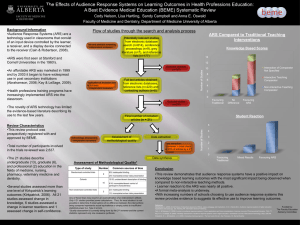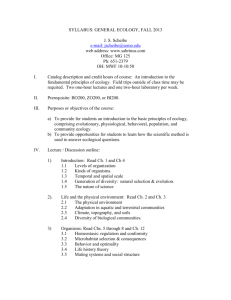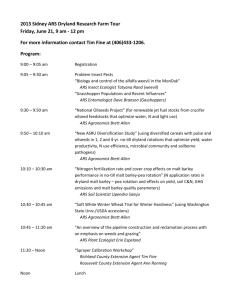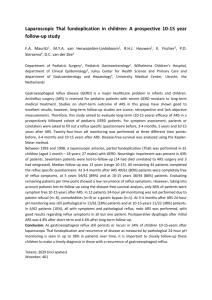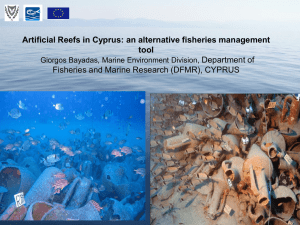ddi12411-sup-0001-AppendixS1
advertisement
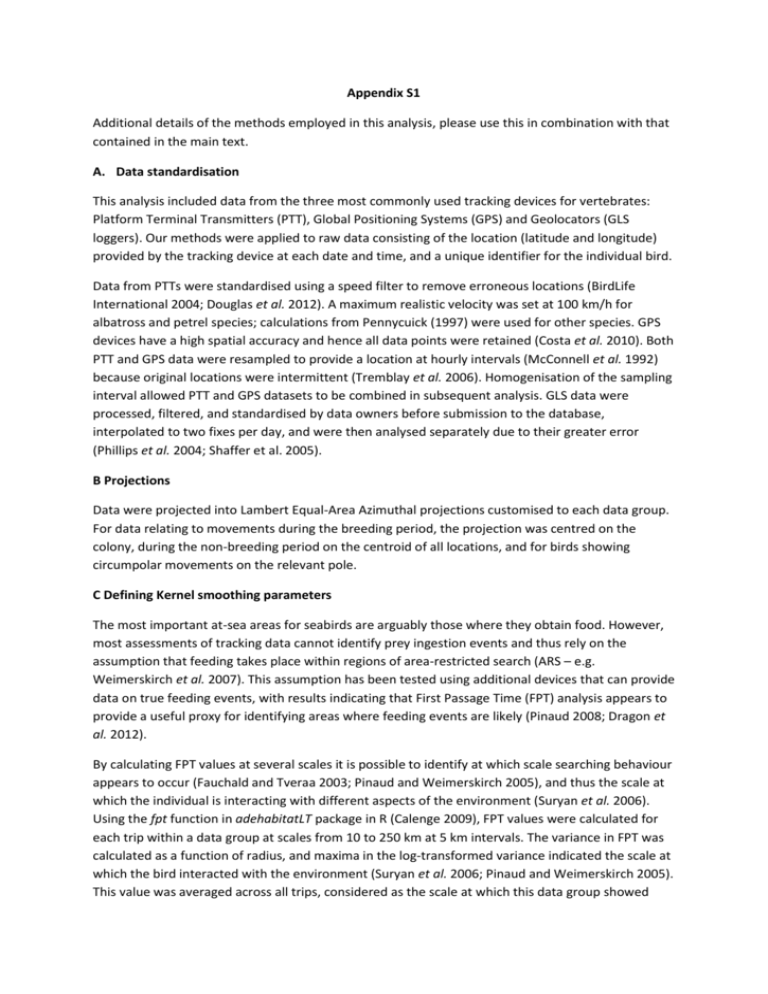
Appendix S1 Additional details of the methods employed in this analysis, please use this in combination with that contained in the main text. A. Data standardisation This analysis included data from the three most commonly used tracking devices for vertebrates: Platform Terminal Transmitters (PTT), Global Positioning Systems (GPS) and Geolocators (GLS loggers). Our methods were applied to raw data consisting of the location (latitude and longitude) provided by the tracking device at each date and time, and a unique identifier for the individual bird. Data from PTTs were standardised using a speed filter to remove erroneous locations (BirdLife International 2004; Douglas et al. 2012). A maximum realistic velocity was set at 100 km/h for albatross and petrel species; calculations from Pennycuick (1997) were used for other species. GPS devices have a high spatial accuracy and hence all data points were retained (Costa et al. 2010). Both PTT and GPS data were resampled to provide a location at hourly intervals (McConnell et al. 1992) because original locations were intermittent (Tremblay et al. 2006). Homogenisation of the sampling interval allowed PTT and GPS datasets to be combined in subsequent analysis. GLS data were processed, filtered, and standardised by data owners before submission to the database, interpolated to two fixes per day, and were then analysed separately due to their greater error (Phillips et al. 2004; Shaffer et al. 2005). B Projections Data were projected into Lambert Equal-Area Azimuthal projections customised to each data group. For data relating to movements during the breeding period, the projection was centred on the colony, during the non-breeding period on the centroid of all locations, and for birds showing circumpolar movements on the relevant pole. C Defining Kernel smoothing parameters The most important at-sea areas for seabirds are arguably those where they obtain food. However, most assessments of tracking data cannot identify prey ingestion events and thus rely on the assumption that feeding takes place within regions of area-restricted search (ARS – e.g. Weimerskirch et al. 2007). This assumption has been tested using additional devices that can provide data on true feeding events, with results indicating that First Passage Time (FPT) analysis appears to provide a useful proxy for identifying areas where feeding events are likely (Pinaud 2008; Dragon et al. 2012). By calculating FPT values at several scales it is possible to identify at which scale searching behaviour appears to occur (Fauchald and Tveraa 2003; Pinaud and Weimerskirch 2005), and thus the scale at which the individual is interacting with different aspects of the environment (Suryan et al. 2006). Using the fpt function in adehabitatLT package in R (Calenge 2009), FPT values were calculated for each trip within a data group at scales from 10 to 250 km at 5 km intervals. The variance in FPT was calculated as a function of radius, and maxima in the log-transformed variance indicated the scale at which the bird interacted with the environment (Suryan et al. 2006; Pinaud and Weimerskirch 2005). This value was averaged across all trips, considered as the scale at which this data group showed searching behaviour, and was used subsequently to determine the kernel smoothing factor for data collected with GPS or PTT devices (Fig. 3 and S1). For GLS data, we used h=186, which corresponds to the average error of the locations in kilometres (Phillips et al. 2004). ARS scales varied considerably between species, devices and seasons (Table S2). Figure 3 and S1: Characterizing the Area Restricted Search patterns of the data group. Each black line shows the log variance in First Passage Time at each scale for an individual foraging trip, dotted red lines show the peak scales for each individual foraging trip (i.e. the ARS scale), assessed from 10 250 km at 5 km intervals, solid red line shows the average ARS scale for the data group which was then used as kernel smoothing factor (h values) for home range estimation. No. data Min ARS Max ARS Ave ARS groups Scale Scale Scale GPS or PTT Breeding 111 11.67 135.87 47.75 GPS or PTT Non-Breeding 12 20 98.19 51.15 Grand Total 123 11.67 135.87 48.08 GLS Breeding 50 186 186 186 GLS Non-Breeding 39 186 186 186 Grand Total 89 186 186 186 Table S2: Summary of results for Area Restricted Search analyses, showing the number of data groups for the breeding and non-breeding seasons split by data capture device types. ARS values for GPS and PTT are the minimum and maximum exhibited within the device/season combination, as well as the average value across all data groups. For GLS 186km was set as a default, rather than calculated, following Phillips et al. 2004. Device/season D. Assessing representativeness In order to assess whether data were representative and allow inferences to be drawn about the spatial use patterns of a population, we examined how core area distribution changes with increasing sample size. We randomly selected individual trips iteratively, and compared the randomly selected (the ‘sampled’) with the unselected (the ‘unsampled’) data. For each sample size, a 50% UD was calculated from the sampled data, using an average ARS scale to define the smoothing factor (Fig. S1). We then assessed what proportion of the unsampled data was located within this 50% UD. Inclusion values were calculated 100 times using different random samples, to assess variability due to random sample selection. Thus, 100 estimates of the inclusion value were obtained for each sample size (i.e. from one to the total number of trips in the data group). A nonlinear regression was used to estimate the sample size needed for a data group to be considered completely representative, even when the inclusion value did not reach an asymptote. The sample size at which a data group is assumed to fully represent the wider population is reached at the point where the rate of increase of the regression function decreases to zero (i.e. when adding new samples simply replicates distributions already sampled). The maximum inclusion value achieved by a data group was calculated as a percentage of the estimated asymptote value to provide a measure of the data group's representativeness. The values obtained from the analysis of representativeness were then used to set the correction factors used when assigning overall populations to a site (Table S3). Table S3: Values obtained from the analysis of representativeness of the tracking data sets and how this translates into the areas selected, and the correction factors used when assigning overall populations to a site. For example in a data group shown to be 70-80% representative only areas used by at least 20% of tracked individuals were selected and were conservatively assumed to be used by up to 50% of the wider population. Representativeness value >90% Core-use threshold Correction Factor 10% 0.9 80%-90% 12.5% 0.75 70%-80% 20% 0.5 <70% or n trips < 15 NA NA E Future improvements to methodology Further improvements may also be possible by additional rigorous tests of the various analytical components underlying our approach. For example, evaluating a species-specific definition of 'core use area' may be useful to further account for variations in ecology and environmental interactions. Integration of data from tracking with data from other devices, such as wet/dry sensors, stomach sensors and accelerometers, may also lead to more accurate definitions of activity patterns and behaviours at sea. We found ARS scales to vary considerably between species, sites and life-history stages, providing further justification for splitting the analysis into data groups. We used the average ARS scale within a data group to assign kernel smoothing values; however ARS assessments often show multiple peaks (e.g. Paiva et al. 2010), reflecting small and large scale searching behaviours or differences between devices, and future analysis could explore how to choose the most effective ARS value for capturing feeding events and assigning kernel smoothing factors. Further, more complex modelling of the raw location data may help to identify more discrete sites. We relied on data providers to process and filter GLS data before submission, but the distribution inferred from GLS data could be improved via state space modelling (Block et al. 2011; Jonsen et al. 2003; Winship et al. 2012), or by comparing temperature data recorded by the same loggers with maps of sea surface temperatures measured by satellite (Shaffer et al., 2005). E. References BirdLife International (2004) Tracking Ocean Wanderers: the global distribution of albatrosses and petrels. Results from the Global Procellariiform Tracking Workshop, 1– 5 September, 2003, Gordon‘s Bay, South Africa. Cambridge, UK: BirdLife International. Block, B.A., Jonsen, I.D., Jorgensen, S.J., Winship, A.J., Shaffer, S.A., Bograd, S.J., Hazen, E.L., Foley, D.G., Breed, G.A., Harrison, A.-L., Ganong, J.E., Swithenbank, A., Castleton, M., Dewar, H., Mate, B.R., Shillinger, G.L., Schaefer, K.M., Benson, S.R., Weise, M.J., Henry, R.W. & Costa, D.P. (2011) Tracking apex marine predator movements in a dynamic ocean. Nature, 475, 86–90. Calenge, C., Dray, S. & Royer-Carenzi, M. (2009) The concept of animals' trajectories from a data analysis perspective. Ecological Informatics, 4, 34-41. Costa, D.P., Robinson, P.W., Arnould, J.P., Harrison, A.L., Simmons, S.E., Hassrick, J.L. & Crocker, D.E. (2010) Accuracy of ARGOS locations of pinnipeds at-sea estimated using Fastloc GPS. PLOS ONE, 5, e8677. Douglas, D.C., Weinzierl, R.C., Davidson, S., Kays, R., Wikelski, M. & Bohrer, G. (2012) Moderating Argos location errors in animal tracking data. Methods in Ecological Evolution, 3, 999-1007. Dragon, A., Bar-Hen, A., Monestiez, P. & Guinet, C. (2012) Comparative analysis of methods for inferring successful foraging areas from Argos and GPS tracking data. Marine Ecology Progress Series, 452, 253-267. Fauchald, P. & Tveraa, T. (2003) Using first-passage time in the analysis of area-restricted search and habitat selection. Ecology, 84, 282–288. Jonsen, I.D., Myers, R.A., Fleming, J.M. (2003) Meta-analysis of animal movements using state-space models. Ecology, 84, 3055-3063. McConnell, B.J., Chambers, C. & Fedak M.A. (1992) Foraging ecology of southern elephant seals in relation to the bathymetry and productivity of the Southern Ocean. Antarctic Science, 4, 393-398. Paiva, V. H., Geraldes, P., Ramírez, I., Garthe, S. and Ramos, J. A. (2010) How area restricted search of a pelagic seabird changes while performing a dual foraging strategy. Oikos, 119: 1423–1434. Pennycuick, C.J. (1997) Actual and optimum flight speeds: field data reassessed. The Journal of Experimental Biology, 200, 2355–2361. Phillips, R., Silk, J., Croxall, J., Afanasyev, V. & Briggs, D. (2004) Accuracy of geolocation estimates for flying seabirds. Marine Ecology Progress Series, 266, 265–272. Pinaud, D. & Weimerskirch, H. (2005) Scale-dependent habitat use in a long-ranging central place predator. Journal of Animal Ecology, 74, 852–863. Pinaud, D. (2008) Quantifying search effort of moving animals at several spatial scales using first passage time analysis: effect of the structure of environment and tracking systems. Journal of Applied Ecology, 45, 91-99. Robinson, P.W, Tremblay, Y., Crocker, D.E., Kappes, M.A., Kuhn, C.E., Shaffer, S.A., Simmons, S.E. & Costa, D.P. (2007) A comparison of indirect measures of feeding behaviour based on ARGOS tracking data. Deep-Sea Research II, 54, 356–368. Shaffer, S.A., Tremblay, Y., Awkerman, J.A., Henry, R.W., Teo, S.L.H. & Anderson, D.J., (2005) Comparison of light- and SST-based geolocation with satellite telemetry in free-ranging albatrosses. Marine Biology, 147, 833 - 843. Suryan, R.M., Sato, F., Balogh, G.R., Hyrenbach, K.D., Sievert, P.R. & Ozaki, K. (2006) Foraging destinations and marine habitat use of short-tailed albatrosses: a multi-scale approach using first passage time analysis. Deep Sea Research Part II: Topical Studies in Oceanography, 53, 370–386. Tremblay, Y., Shaffer, S.A., Fowler, S.L., Kuhn, C.E., McDonald, B.I., Weise, M.J., Bost, C.A., Weimerskirch, H., Crocker, D.E., Goebel, M.E. &Costa, D.P. (2006) Interpolation of animal tracking data in a fluid environment. Journal of Experimental Biology, 209, 128-140. Weimerskirch, H., Pinaud,D., Pawlowski,F. and Bost, C-A. (2007) Does prey capture induce arearestricted search? A fine-scale study using GPS in a marine predator, the wandering albatross. The American Naturalist, 170, 734-743. Winship, A. J., Jorgensen, S. J., Shaffer, S. A., Jonsen, I. D., Robinson, P. W., Costa, D. P. & Block, B. A. (2012) State-space framework for estimating measurement error from double-tagging telemetry experiments. Methods in Ecology and Evolution, 3: 291–302.
